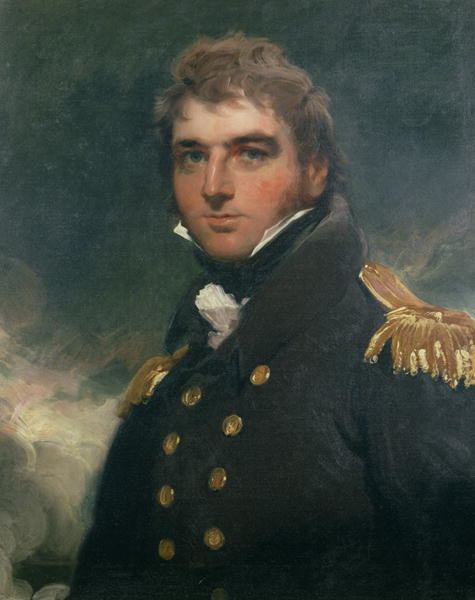Allegiance United Kingdom Role Politician Died January 27, 1839 | Rank Vice Admiral Great-grandparents Edward Bayly Name Charles Paget | |
 | ||
Born 7 October 1778 ( 1778-10-07 ) Commands held Cork StationNorth America and West Indies Station Battles/wars War of 1812Napoleonic Wars Parents Henry Paget, 1st Earl of Uxbridge Grandparents Sir Nicholas Bayly, 2nd Baronet Battles and wars | ||
Vice-Admiral Sir Charles Paget GCH (7 October 1778 – 27 January 1839) was a British sailor who also became a liberal politician and Member of Parliament.
Contents
Naval career
Vice-Admiral Sir Charles Paget (1778–1839) was the son of Henry Bayly Paget, 1st Earl of Uxbridge, and Jane Champagné, and was brother to the second earl who became the first Marquess of Anglesey, famous for losing his leg at the Battle of Waterloo while commanding the cavalry.
Charles joined the Royal Navy in 1790, and by 1797 he was captain of HMS Martin, a sloop of war serving at the Battle of Camperdown.
In 1798 he became post-captain of HMS Brilliant, a small frigate in which he captured le Dragon of 11 guns, and the St Jago, a Spanish privateer of 10 guns. In 1800 he removed into HMS Egyptienne.
Captain Paget's next appointment was to HMS Hydra, a frigate of 38 guns, in which he proceeded to the Mediterranean where he remained about twelve months. On 6 April 1803 he commissioned HMS Endymion, a frigate of the largest class, and in the course of the ensuing summer he captured Bacchante, a French corvette of 18 guns, Adour, a store ship pierced for 20 guns, and General, a Morcau schooner privateer of 16 guns. He subsequently intercepted several richly laden Spanish merchantmen coming from South America, and he also captured Colombe, a French corvette of 10 guns off Ushant.
Towards the close of the long French war, Paget, while cruising in the Endymion on the coast of Spain, sighted a French ship-of-the-line in imminent danger, embayed among rocks upon a lee shore, bowsprit and foremast gone, and riding by a stream cable, her only remaining one. Though it was blowing a gale, Paget bore down to the assistance of his enemy, dropped his sheet anchor on the Frenchman's bow, buoyed the cable, and veered it athwart his hawse. This the disabled ship succeeded in getting in, and thus seven hundred lives were rescued from destruction. After performing this chivalrous action, Endymion, being herself in great peril, hauled to the wind, let go her bower anchor, club-hauled and stood off shore on the other tack.
Paget participated in an attack on a French frigate squadron anchored at Saint-Vaast-la-Hougue at the Action of 15 November 1810, which ultimately led to the destruction of the Elisa.
He was appointed to HMS Superb, another third rate belonging to the Channel Fleet, and during a cruise in the bay of Biscay he took several prizes. In 1814 he was employed on the coast of North America under the orders of Sir Alexander Cochrane by whom he was entrusted with the command of a squadron stationed off New London and took part in an attack upon Wareham, Massachusetts during the War of 1812.
Captain Paget was appointed to the command of HMY Prince Regent on 1 January 1819 and afterwards to the Royal George. He attended King George IV, and before his accession he nominated Charles as a Knight Grand Cross of the Hanoverian Guelphic Order and a Knight Bachelor at Brighton on 19 October 1819. In January 1822, Sir Charles succeeded his brother Lieut Gen Sir Edward Paget as a Groom of the Bedchamber, and he continued to hold that appointment during the whole reign of King William IV.
He was made a commodore on board the Royal George on 26 July 1822 and was advanced to the rank of Rear Admiral on 9 April 1823.
In March 1828 he was appointed Commander in chief on the Cork Station. He attained the rank of Vice Admiral on 10 January 1837 and succeeded Vice Admiral Sir Peter Halkett in the command of the North America and West Indies Squadron using HMS Cornwallis as his flagship.
Sir Charles Paget died onboard HMS Tartarus, whilst she was on her way from Port Royal to Bermuda. His death ensued after a violent attack of yellow fever during which for three days his death was hourly expected. Of his staff of twenty, six had died including Dr Scott the surgeon. Feeling better, but weak, and strangely free from rheumatic pain on 19 January he embarked on board the Tartarus, for the purpose of going to the Bermudas. He was off those islands for three days, but being unable to reach them was obliged to go back to St Thomas's.
Parliament
He was Member of Parliament for the rotten borough of Milborne Port from 1804 to 1806, then succeeded his elder brother Edward Paget as MP for Caernarvon Boroughs from 1806 to 1826, and was its MP again from 1831 to 1835. According to Hansard's records, Paget made no contributions to debates in parliament.
Family
He was buried in St Bartholomew's Church in Rogate in West Sussex. In the same place is buried his daughter Fredericka Georgina Augusta who died at Fair Oak, Rogate on 12 September 1853 aged 13 years. His 15-year-old son Horatio Henry Paget died as a midshipman on board HMS Talbot on 28 April 1828. His son Lieutenant Brownlow Henry Paget died on board HMS Dublin on 18 February 1843, aged 24 years.
His widow died at Fair Oak on 17 August 1843, aged 56 years.
